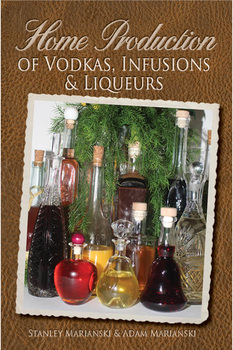
Home Production of Vodkas, Infusions and Liqueurs reveals the rules that govern the process of making vodka and other alcoholic beverages.
"From the start, we decided not to write another recipe book. A collection of recipes does not make a person proficient in a new skill. You have to know the How and Why of making spirits; you have to know the rules that govern the process. And first of all you have to realize that alcohol is just a tool, albeit a very important one. Once you understand how to manipulate the properties of alcohol, the rest will fall into place."
The best vodkas are not made by distilling mash but by mixing different strength alcohols with fruits, herbs and spices. Such infusions are macerated for 3-4 weeks, sweetened or not, filtered and aged for a few months. These infusions are not made with vodkas but with stronger alcohols. As a result superior quality fruit vodka or liqueur with its own natural color is obtained. It does not require distillation which is illegal in the USA and Canada, because it is made with alcohol which is purchased in a store. This method of producing spirits is a common knowledge in any country that lies in a vodka corridor such as Germany, Poland, Lithuania or Russia.
Macerating fruit with alcohol to produce vodkas has been used not only by hobbyists but by commercial producers as well. Infusions or alcohol enhanced fruit juices are stored for future uses. Then when the moment comes, they are mixed together with ingredients such as: sugar, honey, herbs extracts, spices, essential oils and colorings. This is not the favorite method of commercial producers as it increases costs and requires bigger storage areas. However, it produces beverages of superior natural taste and flavor. The book provides all the rules that govern the building process; selecting alcohols of different strength, preparing common extracts such as vanilla, cinnamon or orange skins, using dry and fresh fruit, preparing sugar syrups, proper macerating times, filtering methods and much more.
By the time the book is read, the reader should be able to create his own recipe and this is exactly what the authors intended. They strived to prove that making alcoholic spirits is a form of cooking and not just mixing a few ingredients to make a cocktail. The fruit, herbs and spices are just the materials and alcohol becomes the tool. With skillful manipulation of alcohol's properties, a wide variety of wonderful spirits can be created. To get the reader started, a collection of 103 detailed recipes are included, which can be studied and used as a reference.
By carefully reading this book you will discover that producing new spirits is almost like cooking, one needs to first know the basics and then let the imagination run loose. Everything falls into its place and making new drinks becomes routine. Your spirits develop constant quality, become crystal clear and look beautiful. At this point process becomes an art form. And this is what this book is all about.
